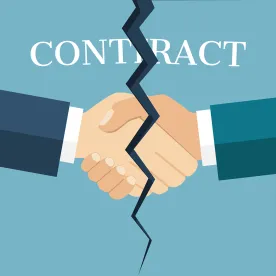The Non-Disclosure Agreement (“NDA”) is a document that is very often prone to misuse in commercial practice. Often, when business teams from two companies get together, the first thing they do, almost as a box-checking measure, is toss over one company’s standard two-way NDA, without much thought as to whether the NDA should, in fact, be a two-way NDA or whether there is even any need for the NDA at all.
When considering entering into an NDA between two commercial entities, the first question to ask is whether it is necessary for either party to be disclosing confidential information. If you must disclose your confidential information, an NDA is a helpful tool to protect that information. However, the best way to protect your confidential information is to not disclose it at all, if it is not necessary for the transaction. Conversely, consider whether and how much confidential information you need to receive from the counterparty. Once you receive that information, you have committed to protecting it under the terms of the NDA.
The NDA is a real agreement, carrying with it real obligations on the parties, and should be treated as such. Keep in mind that NDAs typically do not include consequential damage disclaimers, and breaches of confidentiality are typically expressly carved out from the consequential damage disclaimers included in the operative document that the parties may enter into (like, a master supply agreement, for example). For more information on consequential damage disclaimers and their carve outs, see my blog post here. As such, a breach of an NDA can carry with it large monetary damage awards.
Take the decade-old Hawaiian Airlines case. In this case, Mesa Air Group signed an NDA obligating it to keep confidential certain information disclosed to it by Hawaiian Airlines in connection with Mesa Air Group determining whether to invest in Hawaiian Airlines. Mesa Air Group did not invest in Hawaiian Airlines. Instead, Mesa Air Group began providing air transportation service among the Hawaiian islands in competition with Hawaiian Airlines. The court determined that Mesa Air Group misused Hawaiian Airlines’ information, in particular its projections, when it entered the Hawaiian interisland market. The court awarded Hawaiian Airlines $80,000,000 to compensate for Hawaiian Airlines’ lost profits resulting from Mesa Air Group’s competition.[1]
Scope of the Definition of “Confidential Information”
To limit one’s exposure under an NDA, the scope of the definition of “Confidential Information” should be thoughtfully considered for each relationship, particularly when you are entering into an NDA with a competitor or a potential competitor, as in the Hawaiian Airline’s case. When considering the scope of the definition of “Confidential Information”, you should consider the following question: “Who is disclosing confidential information?”
Neither Party Disclosing Confidential Information. If neither party will be disclosing confidential information, there is no need to execute an NDA.
Only You Disclosing Confidential Information. If only you are disclosing confidential information and the other party will not be disclosing any confidential information to you, then that party should sign a one-way confidentiality agreement, where only that party is agreeing to not use or disclose confidential information. Further, to the extent your bargaining power permits, the definition of “Confidential Information” should be broadly-drafted to capture as much information as possible. You may even include language that “Confidential Information” includes information “reasonably believed” by you to be confidential.
Only the Other Party Disclosing Confidential Information. If the other party is disclosing confidential information and you are not, the other party will likely present you with an NDA to sign. When you are the party receiving the confidential information, you want to ensure that the definition of “Confidential Information” is drafted as narrowly as possible so that you can avoid violating the NDA. For example, you could have the definition only pertain to information relating to some defined subject matter (like the “potential development of a self-filtering water bottle”) and further require that, for any information to be deemed to be Confidential Information, the information must be conspicuously labeled “CONFIDENTIAL.”
You will want to ensure that all of the necessary exceptions to what constitutes “Confidential Information” are included. The most common such exceptions are as follows:
- Information that is already public
- Information that you already know
- Information that a third party rightfully tells you
- Information that you independently develop
Further, you should also ensure there is a carve-out to non-use/non-disclosure obligations for legally-required disclosures. As a drafting note, this should be a carve-out from the non-use/non-disclosure obligations, not from the definition of “Confidential Information.” The distinction here is that such information is still confidential even though its disclosure is legally required.
Both Parties Disclosing Confidential Information. The most common NDA is the mutual NDA, which contemplates that both parties will be disclosing confidential information. By virtue of being mutual, it tends to be more even-handed than a one-way NDA. The definition of “Confidential Information” should be drafted with a balance of the above in mind – you want to draft it narrowly enough that you do not unwittingly violate your obligations to not use or disclose the other party’s information, but not so narrowly that your confidential information is not properly protected.
Disclosure vs. Use
The meat of the NDA is the non-use and non-disclosure provisions. A party receiving confidential information is typically permitted to use the confidential information only to perform its obligations under the relevant agreement. However, the obligation prohibiting disclosure should be absolute (that is, the receiving party is not permitted to disclose confidential information for any reason), other than when legally-compelled.
Confidentiality Period
A requirement to not disclose or use the confidential information of another party is a restrictive covenant and, like other restrictive covenants, must aim to protect a legitimate business interest and its restrictions should be no more restrictive than reasonably necessary. With this in mind, to increase the likelihood that the NDA is enforceable, consider including a reasonable time period during which a party has to maintain the confidentiality obligations under the NDA.
Additionally, the confidentiality period should treat trade secrets separately from other types of confidential information, such that, despite any expiration of the non-use/non-disclosure obligations under the NDA, the receiving party’s obligations as to trade secrets will remain in effect for as long as the trade secrets remain trade secrets under applicable law.
Requirement to Return Confidential Information
An NDA should include a provision requiring that confidential information be returned upon demand by the disclosing party and, in any event, upon termination of the NDA.
Other Terms
On occasion, a party may use an NDA as a means to bind the other party to terms that are not typically found in an NDA. For example, a party may include non-competition, non-solicitation and/or non-circumvention provisions in an NDA. Or, a seller entering into an NDA with a buyer may include a cross reference incorporating its standard terms of sale in order to bind the buyer to those terms for future product sales. Be on the lookout for these terms.
Conclusion
In summary, when entering into an NDA, a party should carefully consider the scope of the definition of “Confidential Information,” pay close attention to the non-use and non-disclosure provisions, include a confidentiality period and a provision providing for the return of the Confidential Information, and ensure that no terms other than those related to confidentiality are included in the NDA.
[1] Hawaiian Airlines, Inc. v. Mesa Air Group, Inc. (In re Hawaiian Airlines, Inc.), United States Bankruptcy Court for the District of Hawaii, October 30, 2007, Case No. 03-00817.




 />i
/>i

